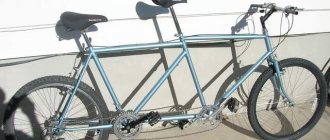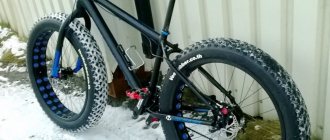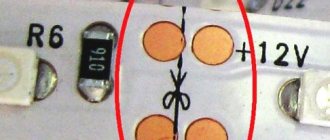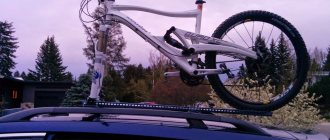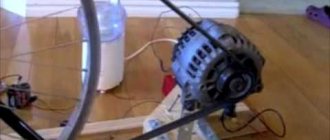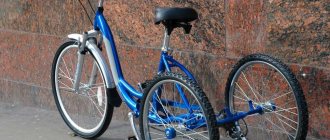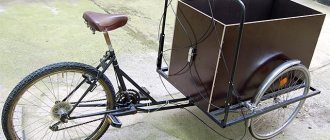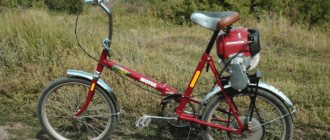A convenient and quite interesting invention of our time is the winter bicycle. The peculiarity of this unique development is its versatility and the ability to attach to any type of bicycle. And thanks to the convenient hinged design, the model turns into a winter version, which has more advanced characteristics and has excellent maneuverability in extreme conditions.
Installation feature
A winter bike from the legendary Ktrak brand can be quickly transformed into a hybrid model that resembles an interesting all-terrain vehicle. Installation of this vehicle can be easily done independently, without outside help. To do this, you must first attach a special ski instead of the front wheel, and add a track structure to the rear wheel. Thanks to its design features, such a bike is able to easily overcome snowdrifts of any depth, without slipping.
Assembling the front part of the snowmobile
First, remove the front wheel from the bike. Now we attach a piece of channel or a U-shaped bracket to the prepared ski in the center. This can be done using regular bolts. Four M8 or M10 bolts will be enough. After this, cut two identical pieces of pipe. We fix the pipes on the bicycle fork (one pipe for each “horn?”). You can firmly secure the tubes to the fork using U-shaped clamps or clamps. A minimum of two fasteners should be used per fork element.
The pipes are attached symmetrically to each other. To give additional rigidity to the extensions constructed on the fork, we drill through holes in the middle of the length of the tubes and tighten them together with a long bolt or pin. After this, we cut the fixed tubes to length so that they are 20–30 cm longer than the bottom of the bicycle.
Let's return to the ski with the bracket. It is necessary to make holes symmetrically to each other on both sides of the channel/bracket. At the edges of the tubes (near the ground) on the fork we drill holes of the same diameter as in the channel. The holes must be at least 11×13 mm. Now we connect the extended fork to the ski through the holes. To do this, we use a long bolt M10-M12. Thus, the ski is installed on the snowmobile. At the same time, it remains movable in the vertical plane, which allows descent/ascent at different angles. You can control the vehicle by turning the steering wheel, just like on a bicycle.
Purpose
It should be noted that this winter bike is intended exclusively for harsh weather conditions. His element is steep mountain slopes and descents, snow-covered forest paths and impassable terrain. Sandy terrain with high slopes and hills will not be an obstacle to traveling on it.
The only taboo for such a vehicle is the urban environment, which includes smooth asphalt and familiar roads.
Snowmobile with a walk-behind tractor engine and inner tubes
The walk-behind tractor practically does not have to be redone if you upgrade the original wheels. You will need lowered tubes from the truck. Five of them are pulled onto each wheel and secured with chains. The cameras are pumping. Due to the fixation with chains, their shape becomes like a daisy with segments in the form of an ellipse. The new wheels will handle deep snow well.
Another wheeled snowmobile can be built from a walk-behind tractor by putting steel hoops on the inner tubes instead of chains. They are equipped with tracks on the outside. The jumpers are welded from metal plates. The height of the track is about 2-3 cm. After inflating the chambers, the metal hoops will be securely fixed to the wheels.
Design features
To move unhindered on any soil, you need to perform the simplest procedure of replacing the rear wheel with a special tracked drive. The design of the latter is quite simple and includes a large wheel and several small ones that perform a transmission role. Thanks to the track-type drive, the contact of this vehicle with the soil is significantly improved, and the winter bicycle becomes more stable.
For lovers of extreme sports and entertainment, winter tires for bicycles are the easiest way out of the situation. After all, replacing it will not allow you to experience all the “delights” of winter driving on snowy mountain slopes. And in order to experience all the advantages of extreme winter descents, you need to replace the front wheel with a specialized ski, which has an additional fork mount.
Replacing structural elements entails a slight increase in the total weight of the bicycle, which, in turn, does not exceed 2.5 kg. The core of the ski is made of wood, the edging of this design is metal.
Buy in the online store, best prices, inexpensive delivery
Snowmobiles are not cheap machines, especially new ones, and even from the world’s leading manufacturers. What about those who, being keen on fishing, hunting, tourism, sports, see a snowmobile, as they say, in a dream or in reality, but do not have sufficient funds to purchase a new car? Of course, you can “stick your head in the credit loop” by paying, albeit in installments, for a new snowmobile an amount that is almost double its actual and already high cost. However, there is another and, perhaps, the most optimal way out of this situation, namely: buy a used snowmobile. And if, after thinking and once again carefully assessing your capabilities, you nevertheless make just such a decision, be careful and do not act rashly.
A used snowmobile is the same as a used car: you can buy it, but carefully and with great caution, observing a number of certain conditions in order to buy, as they say in Odessa, “a thing, not junk.” The sale of used snowmobiles is carried out mainly by quite decent people who will openly tell the buyer about all the weak points of the machine and advise what needs to be paid attention to during operation. However, unfortunately, there are those who like to deceive, and just for this case, here are some tips for new buyers.
Today, shops and markets sell snowmobiles, both new and used, for a variety of purposes and from a variety of manufacturers. YAMAHA snowmobiles. ARCTIC CAT snowmobiles, POLARIS snowmobiles, domestic snowmobiles - it’s simply impossible to list the entire range. At the same time, Yamaha snowmobiles and other snowmobiles from leading foreign manufacturers, as a rule, are quite reliable even after several years of operation. However, having chosen a specific machine, you should contact a competent specialist before making a final decision. If for some reason this is not possible, perform an inspection yourself, but keep in mind: it must be extremely attentive and meticulous.
First of all, make sure that the geometry of the body is correct and that there are no dents or other external damage on it. It is very important that there are no chips, gaps, or cracks on the plastic surfaces of the body and its mating parts - the consequences of a possible accident. Also pay primary attention to the condition of the track: it should not be worn out or torn. Remember that a new caterpillar will cost you no less than a thousand conventional units.
Next, of course, is the engine. Determining its condition visually is very difficult, if not impossible. It is good to have a compression gauge with you and measure the compression in each of the cylinders, making sure that it is present and that there are no discrepancies in the values.
The next point is the condition of the variator, oil, and suspension elements. After checking everything and making sure that it is in working order, ask the seller to start the car and evaluate the rhythm of the engine by ear. It is necessary to try the snowmobile on the move: there should be no knocking, grinding or other extraneous sounds. The car should move smoothly, without jerking, “diving” or jumping.
And in conclusion, one more piece of advice. Today, many localities offer snowmobile rentals. Before you shell out a considerable amount of money to buy a snowmobile, even a used one, think: doesn’t it make sense for you to use this type of service at least initially to gain experience?
: A homemade bicycle with a screw-pull motor or an aero bike.
What should a summer extreme sports enthusiast do if in winter he suddenly feels the urge to ride a mountain bike? Of course, there is always an alternative in the form of skis, although this is not quite the same. But the happiness of the extreme sports enthusiast is already nearby - now you can ride across the snowy expanse on your bike. And even combine it with skiing - if desired.
The Canadian company Ktrak Cycle appeared for a rather simple reason. Its founders were once tired of ordinary bicycles, so they liked the mountain version of this vehicle.
But they soon got bored with mountain bikes, and so the guys from this company decided to make something that could be ridden in different environmental conditions, for example, in winter. Well, and from the mountains. Well, let this “something” remain a bicycle.
These are the transformations you can undergo to your bike in winter. The main thing is not to leave it without wheels.
As a rule, the front wheel of a bicycle is connected to the steering wheel and is used to direct movement, and the rear wheel is the driving wheel (of course, there are all sorts of perversions, but we are not talking about them now). However, in certain situations related, say, to weather conditions, the grip of the wheels on the surface deteriorates so much that the bicycle becomes simply inconvenient, or even quite dangerous, transport.
At the same time, some surfaces - especially snow, sand or mud - become completely “unskatable”. It is for such cases that devices from a so far small series, called, of course, Ktrak, were invented. By the way, this idea is reminiscent of the Shuttle-Bike - the thing that makes all bicycles floating.
Do not use Ktrak until you are familiar with the safety rules
Thanks to Ktrak, you can ride your bike on snow or sand without much difficulty. To do this, instead of the rear wheel, you need to install a special track drive, consisting of a large wheel and several transmission wheels. As a result, contact with the surface improves and the bike becomes much more stable.
But friction is not at all necessary at the point of contact of the steering wheel with the road (if there is one), especially when the bicycle is used for the most interesting thing - going down snowy slopes. Therefore, they decided to do without the front wheel. But not really - they decided to replace it with a ski mounted on a fork. Well, what else if it’s snowing?
Ktrak Cycle will begin selling the first copies of its bikes in January 2007, but orders for them are being accepted now. Rear-wheel drive for an adult bike will cost $400, for a child’s bike – $200. The price of the ski - the one used instead of the front wheel - is $140 for large bikes and $90 for children's bikes.
It's especially nice that adding these parts doesn't make the bike too heavy. After replacing the wheels with skis and a rear-wheel drive system, its weight increases by only two and a half kilograms, or, according to the creators, the weight of six bottles of beer (they have such modest bottles).
The Ktrak wheel is the main part of the bike in case you suddenly need to ride it through snowdrifts in winter
Answering the question “Is it possible to attach a kit to every bicycle?”, Ktrak sellers joke: “No, not to every bike - your bike must have a rear wheel and a saddle post. No other way". But you still need to take into account the sizes of the drives, which the company now makes with a height of 20, 24 and 26 inches.
If you don’t know that these photographs depict the testing of the first Ktrak samples, the joy of these people, for some reason cutting through the snow on bicycles, seems pointless
The kits use modern materials for metal components - aircraft aluminum, for wheel coverings - reinforced nylon; The track belt is made of reinforced polyurethane. The ski is made of wood coated with plastic.
Perhaps someone will say that cycling in the snow is not so convenient and fun. But no: as Ktrak Cycle assures us, this kind of riding is really great fun. You can watch the video on YouTube, it definitely won’t let you lie.
Perhaps both skiers and snowboarders will envy the sensations of riding bicycles with Ktrak
This was confirmed by the Interbike exhibition in Los Angeles, where Ktrak attracted the attention of many visitors in September. “People wanted to buy Ktrak right at the show,” says Kyle Reeves, an employee of the Canadian company. “Dealers were also very interested in our development.”
And riding on freshly fallen snow, by the way, is inconvenient not only on a regular bicycle, but also on a motorcycle.
A motorcycle from an unknown manufacturer, equipped with bells and whistles from SnoXcycle. Judging by the comments on the manufacturer’s website, the main idea of the development is to make the motorcycle available all year round
That’s why, somewhere in the Rocky Mountains, a few years ago, an analogue of Ktrak, the SnoXcycle, was “developed and tested” for motor vehicles. This is a similar set of a special ski and drive with gear wheels and a caterpillar track. True, it is not suitable for all models, but the list includes motorcycles of the most famous brands - Honda, Husaberg, Husqvarna, Kawasaki, KTM, Suzuki, Yamaha - which is also not bad.
In Canada they also produce something similar in appearance - Snow Hawk. This is a motorcycle, or more precisely, a snowmobile, designed for driving in snowy expanses. It has both a front ski and a rear track drive. However, these are entire motorcycles, and not “a set of attachments.” Well, that’s okay, that’ll do too - as an option.
Snow Hawk - just as dashing and very similar. But a little off topic.
Of course, motorcycles cope with such conditions more dashingly and spectacularly. But still, a motorcycle with a front ski and a rear track is still not bad in the snow, although, unlike the “corrected” bicycles, it is not so good in mud and sand. In addition, as lovers of all kinds of “green” technologies, we would like to remind you that the motor version, on top of everything else, is not yet very environmentally friendly.
Rear-wheel drive and its specifics
Such a high-tech feature of the model as rear-wheel drive is quite convenient and necessary in cold weather. The winter bike has a track made of reinforced polyurethane and a frame made of specialized aircraft aluminum. The main wheel of the structure is made of reinforced nylon.
The manufacturer of this innovative system paid sufficient attention to reliability and user comfort. To provide these two important functions, a rather unique gas-assisted oil-type shock absorber was patented. The weight gain when installing rear-wheel drive is insignificant and practically unnoticeable.
Working with the drive part of vehicles
First, remove the rear wheel from the bike.
Instead, a tracked chassis will be installed. If you couldn’t buy ready-made tracks, then we make them from rubber with our own hands. You should cut a strip about 40×50 cm wide. We stuff metal, plastic or wooden strips onto one side of the prepared piece of rubber. These small elements for the snowmobile will serve as snow hooks, so it is best to make them higher. We connect the edges of the rubber to each other to form a closed piece with snow hooks on the surface. We assemble the wheels in pairs on the axle. Taking into account the diameter of the wheels and the length of the assembled track, it is necessary to make a frame that will serve as a common platform for all three pairs of rollers. We mount two pairs of wheels tightly to the frame, and the third outer pair is movable in a horizontal plane. Its mobility will ensure good rubber tension, and as a result, prevent the tracks from slipping. We attach the sprocket from the rear wheel of the motorcycle to the axle of the first pair of wheels.
The assembled frame with track must be installed at the rear of the bicycle. This can be done by welding the drive frame to the bike frame with plates. However, if the frame is large, made of titanium or aluminum, then the drive should be secured with bolts, since at home it is unlikely to be able to weld to non-ferrous metal. The distance from the caterpillar to the frame must be at least 5×10 cm.
Let's start installing the power unit on the snowmobile. The best place for the motor is the horns behind the seat. There the engine will not interfere with your legs and there will be no fear of getting burned on it. However, you can place it in the center of the frame, but only with the top trim. It is worth noting that it is best to place the engine with the shift paw in the middle of the frame, and it is advisable to place the motor with the gear shift on the steering handle at the rear.
The engine is placed on the snowmobile so that its sprocket is above the track drive sprocket. When installing the power unit, additional welding of the plates and channel will be required to fix it on the bicycle frame. You should know how to weld them on site. After this, you need to make a chain of the required length and connect the sprockets. We mount the tank as close to the engine as possible.
Manufacturer's advice
Winter tires for a bicycle are not always the best option in cold weather or for riding on sandy soil and mud. To ride on snowy slopes, the wheel must be replaced with a ski. The manufacturer recommends that every winter driving enthusiast equip their vehicle with the Ktrak system. It is compatible with any bike that has a seatpost and a rear wheel.
An additional convenience will be the presence of a quick wheel change system, which is present in most modern models. This opportunity will allow you to install the innovative Ktrak system without the use of specialized tools.
What can you take from your bike?
It would seem that there is nothing to remove from a bicycle to make a snowmobile. However, to make a snowmobile with your own hands you will need almost the entire bike. In particular, for a bike, you will need the entire frame, fork, and seat.
In order to make a snowmobile, it is best to use a mountain version or any other with a reinforced, lightweight frame and a wide range of speeds. It is advisable to use a motorcycle engine as a power unit. It has a small mass, but at the same time produces quite good torque and speed. In particular, you can take the engine from the Minsk motorcycle. or ?Izh?.
With your own hands you can make a snowmobile that can accelerate to a speed of 30–50 km/h on a flat track. Winter transport from a bicycle is designed for one person, whose weight is up to 80–100 kg. At the same time, the snowmobile can also move a small additional load.
In addition to spare parts for the bike, you will need the following parts and products:
- a ski with a length of 60 to 80 cm and the wider the better;
- two pieces of iron pipe with a diameter of up to 50 mm (it is best to use a lightweight aluminum pipe, but with a thick wall);
- a piece of channel or U-shaped bracket;
- metal plate 25×50 mm wide and 4×5 mm thick;
- square profile;
- thick rubber or ready-made tracks. Finished products for the chassis can be found on the construction equipment market. For example, the tracks needed for a snowmobile will fit from a mini-excavator;
- three pairs of metal (preferably) wheels from a small cart.
Tools you will need:
- set of wrenches;
- pliers;
- hammer;
- welding machine;
- drill.
[ads-pc-1]
Winter tires for bicycles
The Ktrak brand bicycle is not the only example of equipment that can be used for extreme winter riding on mountain slopes. It is possible to purchase two-wheeled vehicles with special tires and tires. Its winter tires are equipped with special studs and treads that absolutely prevent skidding and sliding on ice.
There are two ways out of the situation that are absolutely equivalent. In the first case, you just need to purchase a specialized winter bike. The second is to equip an existing vehicle with winter attributes, which should include winter tires for a bicycle.
Snowmobile idea from a bike
The idea arose to make a snowmobile based on a bicycle frame; the thing, of course, is not very powerful, but for walking in the snow to feel all the joy of freely crossing space, it would be very suitable.
By the way, he had an old and already unusable bicycle in his barn, which became the donor for the implementation of this practical idea.
Consider the design of a snowmobile based on a bicycle frame
Everything is very concise and does not stray too far from the simple concept of the bike itself. The rear wheel acts as a pneumatic wheel or unicycle, and a skateboard ski is tucked into the front fork. The rear fork had to be adjusted to fit the large air tire. Such a simple structure of a snowmobile based on a bicycle with a ski.
Let's now consider what elements and materials are needed for this development: a bicycle, a camera from a Niva car, tarpaulin, a sheet of aluminum, a ski from a skateboard, a piece of pipe.
Tools: welding machine, sandpaper, grinder, hammer, wrenches, lathe, glue. For the pre-wheel, the master made a fork, as shown in the photo below.
At the second stage, a metal wheel was made, and an extension was made from an aluminum sheet. Next, the above-mentioned Niva camera was installed on the wheel. The wheel was equipped with a canvas cover.
On the front fork I put a ski from a skateboard that was unnecessary for my direct purposes.
That's the whole laconic structure of a bicycle-snowmobile, which is not so difficult to repeat and can be made, if desired, in an ordinary workshop. The photo below shows a test of the resulting bicycle snowmobile in the field.
Customer Reviews
According to many buyers, the Ktrak brand bicycle, despite its external instability, attracts a lot of attention. From driving this extreme transport you can get not only adrenaline, but also a lot of positive emotions. Despite its comical and slightly awkward appearance, the bike has excellent cross-country ability and provides comfortable descent on snowy slopes.
From the point of view of buyers of this winter bike model, such a vehicle causes a lot of controversy. Its negative aspects include quite a lot of weight, high cost and poor stability on snow. The positive side of the Ktrak bike is the overwhelming adrenaline that you can get during the ride.
Calculation and assembly of caterpillars
The caterpillar is a tape, on the outer surface of which tracks are attached. Tracks are rigid lugs installed along the entire length of the tracks. Track options:
- Made from 3mm thick transport tape.
- From a car tire.
- From V-belts.
- Ready-made factory-made tracks.
The conveyor belt must be looped. Its strength is only sufficient for light snowmobiles with engines no more powerful than 10 liters. With. Car tires are stronger than tape and are suitable for powerful engines. Solid tires do not need to be looped, so the likelihood of a rupture is minimal. It is more difficult to choose a tire of the required length than a tape.
Finished tracks are removed from other similar equipment (snowmobiles “Buran”, “Sherkhan”). They are equipped with lugs from the factory. The products are not suitable for use with low-power motors from walk-behind tractors. Homemade snowmobiles made from Buranovsky tracks must have gears from the same “donor”.
The size of the caterpillar is selected according to the required driving characteristics: the larger the width, the lower the handling, but the higher the maneuverability. The minimum area of the contact patch from the snowmobile (skis and tracks) must be such that the pressure from the equipped vehicle does not exceed 0.4 kg/cm2 of surface. Light snowmobiles use a 300 mm wide conveyor belt, cut lengthwise into 2 strips of 150 mm each.
Preparing the Tape
The tracks are attached to homemade tracks with M6 bolts with a wide head. The bolts are fixed with a nut, a washer and a groover are used. Before fastening, leading holes with a diameter of 6 mm are drilled in the tape and tracks. When drilling, use a jig and wood drills with special sharpening.
The conveyor belt is also looped with M6 bolts. To do this, the edges of the tapes are overlapped with an overlap of 3-5 cm, the connection contains 1-2 rows of bolts. For a 150 mm wide track, the following distances are maintained:
- From the edge of the tape 15-20 mm.
- Between bolts on tracks 100-120 mm.
- Between the bolts when banding 25-30 mm.
In total, one track requires 2 bolts, and one belt connection requires 5-10 bolts, depending on the number of rows. When using car tires, only the tread is left, and the sidewalls are removed with a shoe knife.
Homemade lugs
The tracks are made of polyethylene pipe with a diameter of 40 mm with a wall thickness of 5 mm, sawn in half in the longitudinal direction. The entire section of the lug is adjacent to the tape. In light snowmobiles, one track connects the tracked pair. With a track width of 150 mm, the track length is 450-500 mm.
The lugs are cut using a wood circular saw. They use a special machine with two guides (metal and wood), rigidly fixed on a fixed tabletop. The walls of the pipes are sawed one by one.
The distance between the tracks depends on the parameters of the gears on the drive shaft. Typically 5−7 cm. The specified distance is maintained with an error of no more than 3 mm. Otherwise, the operation of the drive is disrupted: the lugs “run” onto the teeth of the drive wheels, the caterpillar begins to slip and fly off the rollers.
Brakes
For dry weather, you can safely choose V-breaks, but for snow, frost and slush, it is better to use disc brakes. Such systems are capable of self-cleaning, they have more reliable pads, and the disk life tends to infinity. The same cannot be said about the aluminum rim.
If there are hydraulics, it is necessary to check its condition, tighten the connections and nuts of the fittings. If you have vibration breaks, you need to remember the following points:
- the service life of such pads in winter does not exceed 200 km, so they need to be checked regularly;
- when snow sticks to the rims, it becomes ice, so you will need to slow down periodically;
- anodized rims behave better in winter;
- bushings need good protection from moisture and dirt;
- bulk bearings and boots require replacement of lubricant;
- Aluminum nipples should not be placed on the spokes of a winter bicycle, as they will turn sour after a short time.
Classification of children's snowmobiles
The electric children's snowmobile runs on rechargeable batteries. Such power supplies do not require any maintenance other than periodic recharging. Self-discharge is completely eliminated due to the special design of the batteries.
Some children's vehicles use gasoline engines as their power source. Different types of motors are installed on such vehicles. Children's snowmobiles with two-stroke gasoline engines are lightweight, easy to maintain, warm up quickly, and can run on cheap fuel. Four-stroke engines make less noise during operation. They have lower fuel consumption and a much longer working life.
Some motors have an air cooling system. It must be used correctly to prevent overheating. The hydraulic cooling system uses ordinary snow.
Injection engines have a number of advantages: stable operation, environmental friendliness and efficiency. They are not reliable and are not recommended for use in field conditions. It is advisable to refuel the engines in children's snowmobiles with unleaded gasoline to reduce harmful emissions and increase engine life.
The ideal bike for winter - what is it?
Based on the information presented above, you can easily draw a picture of the ideal bicycle for the winter period and determine for yourself the main points that require your participation.
- The bicycle must be heavy, in this case the wind will not blow away and change the trajectory of movement.
- A steel frame will not cause problems and will not require complex maintenance. This material tolerates low temperatures well.
- The wheels should have strong treads with spikes, which will be previously rolled in. Although the wheels themselves will still need constant care and require careful driving, since they are made of aluminum.
- A lot has been said about forks, and probably each of you has realized the uselessness of oil forks and the advantages of spring-elastomer models.
- For brakes, it is permissible to choose exclusively mechanical disc options. Because the rim system will refuse to work after several revolutions in the snow, and the hydraulics will freeze and even DOT-4 will not help here.
- Choosing pedals is also no longer a big problem. The main thing is not to choose contact options, since there is a high probability of not having time to free your leg during a fall.
- Small things like switches and brake levers can only be made of metal, since plastic will become brittle in the cold and can break even with light pressure.
- When choosing a sprocket, ratchet and chain, special attention must be paid to the thickness of the metal. In winter, you should not chase a large number of speeds, since as they increase, the thickness of the sprockets and chain decreases.
- In a winter bicycle, all components, joints and friction points must be lubricated. The lubricant must be liquid. This may be a graphite product or liquid gear oil.
Other devices
You can easily and quickly make an angle grinder from a saw that can work autonomously and have high power. For such a transformation, you need to buy the necessary attachments at a building materials store that will help transform one tool into another. To reduce the likelihood of blade breakage, the saw can be equipped with a protective casing, and the number of revolutions can be reduced with a high-speed gearbox.
A good solution is to make a portable generator set from a saw. It will come in handy in a summer cottage where there is no electricity. A power of twelve volts will be enough to provide illumination as from a normal flashlight.
By connecting the inventor, you can convert the energy to 220 volts.
Among the useful homemade products you can add a motor to an inflatable boat, a motorcycle (you will need more than one saw for it), and a light aircraft.
Suspension fork
Whatever the design of the suspension fork, its characteristics will still change when exposed to sub-zero temperatures. The degree of its swelling depends on the low level of the fork. It is not possible to correct this situation, so all that remains is to humbly accept this fact.
The spring-elastomer fork will become stiffer, and the spring-oil fork will work more slowly due to thickening of the oil. If such a situation arises, it is worth refusing to use a lockout so as not to cause damage to the damper. The situation can be alleviated by using thinner oil and adjusting the rebound of the fork in accordance with the temperature at which it is operated.
If an air fork is used, you will need to increase the air pressure level until the sag returns to normal. This procedure must be performed outdoors.
The pants on the fork must be protected from aggressive influences to prevent the formation of corrosion. Modern forks are often made on the basis of magnesium, which, as we already know, actively enters into chemical reactions with other elements. For winter riding, you can choose an inexpensive fork with high rigidity, which are mostly used in trials bikes.
Let's move on to practice
The frame, made of pipes or angles, is primarily equipped with a steering mechanism. Having chosen the height and angle of inclination, spot weld the element
Install and secure the motor according to the drawing, taking care not to tilt too much. The snowmobile should not have a long fuel line, so try to position the tank close to the carburetor
The next step is to install the track. Mount the driven axle with the canvas on at the back of the frame (on the fork, suspension, shock absorber, etc., depending on the type of structure), the drive axle - in the middle part of the snowmobile (most often under the driver's seat), in the shortest possible connection with the engine. The gears of both axles are pre-engaged.
